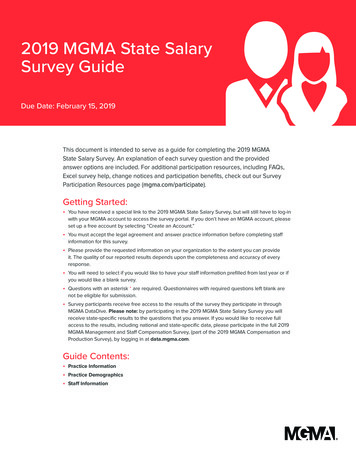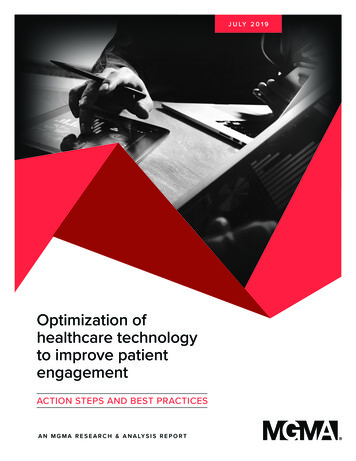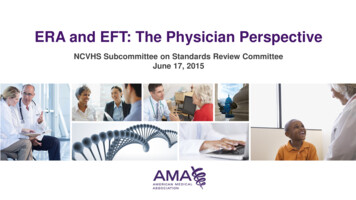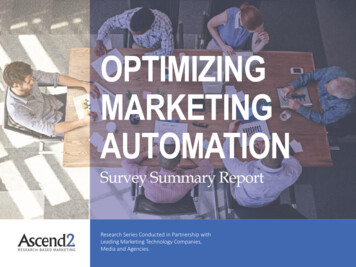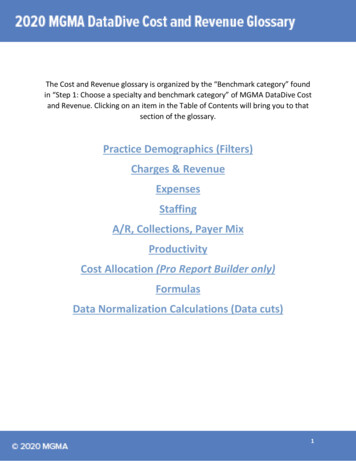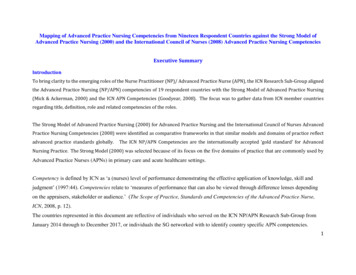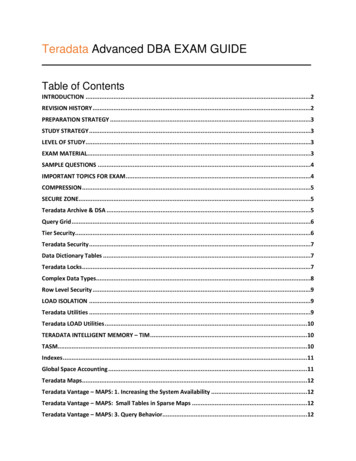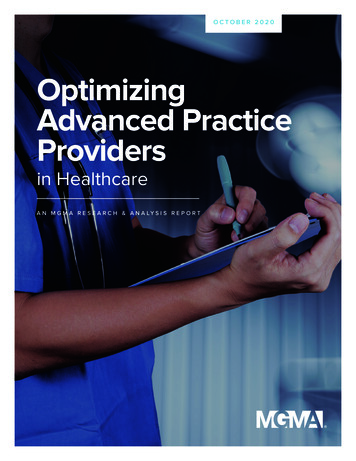
Transcription
OCTOBER 2020OptimizingAdvanced PracticeProvidersin HealthcareA N M G M A R E S E A R C H & A N A LY S I S R E P O R T
ContentsIntroduction . . . . . . . . . . . . . . . . . . . . . . . . . 4An upward trajectory for APPs . . . . . . . . . 5APPs as outlined by CMS . . . . . . . . . . . . . 6APPs and incident-to billing . . . . . . . . . . . . . . . . 7APP compensation andpayment structures . . . . . . . . . . . . . . . . . . 8APP compensation structures . . . . . . . . . . . . . . 8When does hiring an APP make sense? . . . . 10APPs and value-based care . . . . . . . . . . . . . . . 11Specialty-specific insightsinto APP use . . . . . . . . . . . . . . . . . . . . . . . 13Anesthesiology and CRNAs . . . . . . . . . . . . . . . 13Credentialing and consumerismin pediatrics . . . . . . . . . . . . . . . . . . . . . . . . . . . . 14The APP and behavioral health . . . . . . . . . . . 15Staffing in urgent care . . . . . . . . . . . . . . . . . . . 16APPs, state by state . . . . . . . . . . . . . . . . . 17PA rules across the United States(as of October 2020) . . . . . . . . . . . . . . . . . . . . . 18Conclusion . . . . . . . . . . . . . . . . . . . . . . . . . 19Notes . . . . . . . . . . . . . . . . . . . . . . . . . . . . . . . . . . 19
O P T I M I Z I N G A D VA N C E D P R A C T I C E P R O V I D E R S I N H E A LT H C A R EIntroductionThe COVID-19 pandemic has amplified the previously growing importance of advancedpractice providers (APPs) in care delivery and practice performance.Increasing demands for healthcare point to a projected physician shortage, estimatedto reach between 54,100 and 139,000 physicians by 2033.1 One strategy to address thisshortage is to close gaps in primary care access through increased use of APPs. Oneestimate points to expanded use of nurse practitioners (NPs) could reduce primary carephysician (PCP) shortages by 70%.2Many practices already recognize the substantial boost that APPs can provide to practiceperformance, with APP utilization growing. MGMA data show that almost 67% of BetterPerformer practices employ APPs; for physician-owned practices, that rate jumps toalmost 87%.3Defining APPsAPPs — specially trained and licensed individuals who can provide medical care and billableservices — have been called “advanced clinicians,” “nonphysician providers” and “midlevels.”These providers include: Physician assistants (PAs) are nationally certified and state-licensed medicalprofessionals who practice medicine with physicians and other providers. They practiceand prescribe medication in all 50 states, the District of Columbia, most of the U.S.territories and the uniformed services.4 Nurse practitioners (NPs) are independently licensed healthcare professionals whopossess a master’s or doctorate degree. They diagnose and treat medical conditionsby prescribing medication, ordering and interpreting diagnostic tests, and performinginvasive procedures.5 Advanced practice registered nurses (APRNs) are nurses with at least a master’s degreein nursing.6 There are four types of APRNs:1. Certified nurse-midwives (CNMs) are registered nurses who have graduated from anurse-midwifery education program accredited by the Accreditation Commission forMidwifery Education (ACME) and have passed a national certification examination.72. Clinical nurse specialists (CNSs) are expert clinicians with advanced educationand training in a specialized area of nursing practice who work in a wide variety ofhealthcare settings. A CNS’ specialty may be defined by patient population, caresetting, disease or type of problem, or type of care.83. Clinical social workers (CSWs) have a post-graduate degree in social work with anemphasis on clinical experience and provide mental health services for the prevention,diagnosis, and treatment of mental, behavioral, and emotional disorders in individuals,families, and groups.94. Certified registered nurse anesthetists (CRNAs) are advanced practice registerednurses with graduate level education who provide anesthetics to patients in everypractice setting, and for every type of surgery or procedure. They are the soleanesthesia providers in nearly all rural hospitals and the main provider of anesthesia tothe men and women serving in the U.S. Armed Forces.10 2020 MGMA. ALL RIGHTS RESERVED.4
A N M G M A R E S E A R C H & A N A LY S I S R E P O R TAn upward trajectory for APPsMedical practices across the United States are increasing their use of APPs. MGMA datafound that the APP-to-physician ratio has increased from 0.42:1 in 2012 to 0.60:1in 2019.11A June 2020 report by the Association of American Medical Colleges (AAMC) estimatedthere were 131,200 certified PAs and 248,000 advanced practice registered nurses (APRNs)at the end of 2018. The same report also estimates the supply of APRNs to grow by276,000 full-time-equivalent (FTE) workers and the supply of PAs to grow by nearly138,000 by 2033.12The COVID-19 pandemic has intensified this upward trajectory for APPs, as a 2020 MerrittHawkins report finds that NPs are the second-most in-demand healthcare worker, behindonly family medicine.13 With the projected physician shortage, it is clear APPs will play a largerole in care delivery going forward, driving a need for more APPs to enter the field amid anoptimistic job market.As more doctors reach retirement age, the physician shortage will get worse, especiallywith the stress of the COVID-19 pandemic, according to MGMA consultant Alan J. Beason,MS, FACMPE. “We need to push as much as we can to the next level of licensure andcertification [to] take some of that burden off the doctors,” Beason says.Lower numbers of primary care/family medicine physicians could even lead to an increase inthe business model of a nurse practitioner-owned and -operated practice in states that permitit, according to Lorri M. Phipps, DNP, CPNP-PC, pediatric nurse practitioner, president andco-owner, Mainstreet Pediatrics, Parker, Colo.The demand for APPs is already reflected in the growth of the overall employment of thesehealthcare professionals, as well as rising compensation. Median NP compensation reached 111,238 in 2019, according to 2020 MGMADataDive Provider Compensation data.14 The U.S. Bureau of Labor Statistics (BLS)estimates overall employment will grow at a rate of 45% — much faster than theaverage for all occupations.15 2020 MGMA DataDive Provider Compensation data also show that PAs earned amedian salary of 112,260 in 2019 — a 6.8% increase from 2015 levels.16 The PAfield is growing at a rate of 31%, per BLS.175 2020 MGMA. ALL RIGHTS RESERVED.
O P T I M I Z I N G A D VA N C E D P R A C T I C E P R O V I D E R S I N H E A LT H C A R EThe APP as outlined by CMSCMS defines the qualifications, covered services and level of supervision for NPs and PAs for the Medicare program asoutlined below.18NP qualificationsPA qualifications Be a registered professional nurse who is authorized by thestate in which the services are furnished to practice as a nursepractitioner (NP) in accordance with state law; and Be certified as an NP by a recognized national certifying bodythat has established standards for NPs; or Be a registered professional who is authorized by the state inwhich the services are furnished to practice as an NP byDec. 31, 2000. Have graduated from a PA educational program that is accreditedby the Accreditation Review Commission on Education for thePhysician Assistant (or its predecessor agencies, the Commissionon Accreditation of Allied Health Education Programs [CAAHEP]and the Committee on Allied Health Education and Accreditation[CAHEA]); or Have passed the national certification examination that isadministered by the National Commission on Certification ofPhysician Assistants (NCCPA); and Be licensed by the state to practice as a PA.Covered servicesCovered servicesCoverage is limited to the services an NP is legally authorized toperform in accordance with state law (or state regulatory mechanismestablished by state law). Services may be covered under Part B ifall of the following conditions are met: They are the type that are considered physicians’ services iffurnished by a doctor of medicine or osteopathy (MD/DO); They are performed by a person who meets all NP qualifications; The NP is legally authorized to perform the services in the state inwhich they are performed; They are performed in collaboration with an MD/DO; and They are not otherwise precluded from coverage because of oneof the statutory exclusions.Incident to: If covered NP services are furnished, services andsupplies furnished incident to the NP may also be covered if theywould have been covered when furnished incident to the services ofan MD/DO.Coverage is limited to the services a PA is legally authorized toperform in accordance with state law (or state regulatory mechanismestablished by state law). Services may be covered under Part B ifall of the following conditions are met: They are the type that are considered physicians’ services iffurnished by a doctor of medicine or osteopathy (MD/DO); They are performed by a person who meets all PA qualifications; The PA is legally authorized to perform the services in the state inwhich they are performed They are performed under the general supervision of anMD/DO; and They are not otherwise precluded from coverage because of oneof the statutory exclusions.Incident to: If covered PA services are furnished, services andsupplies furnished incident to the PA’s services may also be coveredif they would have been covered when furnished incident to theservices of an MD/DO.Direct billing and paymentDirect billing and paymentDirect billing and payment for NP services may be made to the NP.Reimbursement is 85% of the fee schedule amount for physicians.Payment for the services of a PA may be made only to theactual qualified employer of the PA. Reimbursement is 85% ofthe fee schedule amount for physicians. Not eligible for directreimbursement.CollaborationPhysician supervisionCollaboration is a process in which an NP works with one or morephysicians (MDs/DOs) to deliver healthcare services, with medicaldirection and appropriate supervision as required by the law of thestate in which the services are furnished.In the absence of state law governing collaboration, collaborationis to be evidenced by NPs documenting their scope of practice andindicating the relationships that they have with physicians to dealwith issues outside their scope of practice.The collaborating physician does not need to be present with theNP when the services are furnished or to make an independentevaluation of each patient who is seen by the NP.The PA’s physician supervisor (or a physician designated by thesupervising physician or employer as provided under state law orregulations) is primarily responsible for the overall direction andmanagement of the PA’s professional activities and for assuring thatthe services provided are medically appropriate for the patient.The physician supervisor (or physician designee) need not bephysically present with the PA when a service is being furnished toa patient and may be contacted by telephone, if necessary, unlessstate law or regulations require otherwise. 2020 MGMA. ALL RIGHTS RESERVED.6
A N M G M A R E S E A R C H & A N A LY S I S R E P O R TThe APP and incident-to billingMedicare’s rules on incident-to billing allow 100% reimbursement for services provided byAPPs instead of the standard 85% for APP services — if certain requirements are met: The physician must initiate the care and remain actively involved and control themanagement of the patient’s condition. The physician must be present in the office suite and be immediately available to provideassistance and direction when the APP is performing services. Incident-to can only bebilled as outpatient office as place of service. If a new problem is introduced, the visit is not incident-to and cannot be billed as such. New patient visits, visits in a hospital or skilled nursing facility setting, and annual wellnessvisits are also services that do not qualify for incident-to billing. Documentation of the incident-to service must include the link to the physician’s service towhich the service is incidental. Referencing by date and location the initiating provider’s service will support the activeinvolvement of the physician. The APP’s identity and credentials must be recorded in the medical record, as well as thename of the supervising physician for the encounter. The supervising physician does not need to be the same provider who ordered theincident-to service. The supervising provider’s number should then be used for billing the service.In summary, incident-to is defined as services or supplies that are: Furnished incident to a physician’s professional services when the services or suppliesare furnished as an integral — although incidental — part of the physician’s personalprofessional services Part of the patient’s course of treatment An expense to the physician.If incident-to requirements are met, services may be reported under the physician’s nationalprovider identifier (NPI). If incident-to requirements are not met, services must be reportedunder the APP’s NPI.7 2020 MGMA. ALL RIGHTS RESERVED.
O P T I M I Z I N G A D VA N C E D P R A C T I C E P R O V I D E R S I N H E A LT H C A R EAPP compensation and payment structuresIt is clear that not only the number of APPs is growing but also the rate of compensation. Thisleads to the question of how are the compensation agreements structured for APPs, as thereare many different options and methodologies.APP compensation structuresThere are many different types of compensation models for APPs. The typical compensationmodels are as follows: Salary Salary plus bonus (based on productivity and/or quality measures) Hourly Full production based– wRVU conversion rate– Percentage of fees billed/collected 2020 MGMA. ALL RIGHTS RESERVED.8
A N M G M A R E S E A R C H & A N A LY S I S R E P O R TAPP compensation models can vary based on the individual circumstances of the practice.Generally, in situations in which an APP is consistently seeing non-billable visits, such aspost-op follow-up visits or global OB visits, it makes sense for a straight salary to be paidversus compensation based on production. If the APP is providing billable visits, a model thatincentivizes both productivity and quality makes sense. APPs who provide surgical assistanceare generally compensated at higher levels than those who don’t.When putting together a bonus structure, it is important to know if the basis of the bonuswill be cash net revenue, wRVUs and/or other quality-based metrics. If you will be offering abonus above a salary, establish either a flat bonus rate, a percentage of cash net revenue ora wRVU conversion rate that will be used to calculate the bonus, which often begins after thebase salary has been met.An example of this is an APP who has a “greater of” -based contract with a base salary of 90,000 per year and a bonus incentive based on wRVU production. The wRVU conversionrate in this example is 32 per wRVU. If the APP achieved 3,500 wRVUs, that would equateto 112,000. The APP would effectively receive the minimum base salary of 90,000 plusthe 22,000 bonus based on production for a grand total of 112,000, or more if productivityincreases continue.In addition to wages there are benefits that need to be considered as well. Health/dentalinsurance, malpractice insurance, CME expenses, dues/subscriptions, retirement matching/contributions [401(k)], vacation days, and cell phone expense reimbursement should allbe considered. Know before posting the position whether it will be fulltime, parttime, orsupplemental and which days/times the shift will cover. Fair market value (FMV) should alsobe taken into consideration when making an offer to an APP.There is no doubt that as the demand for APP services continues to rise, so will theexpectation for higher compensation.PROVIDER COMPENSATION TOOLS MGMA RVU Calculator Tool Overview — To calculate work RVUs, practice experience RVUs and more Provider Production Overview — Details on total RVUs, work RVUs and other elements of MGMA’sCompensation and Production Survey Sample Compensation Model Tables — PDF download for wRVU, tiered wRVU, net revenue and partnershipcompensation models for physicians MGMA DataDive Provider Compensation — Industry-leading benchmarking data for APP specialties basedon your organization’s profile (size, region, ownership) MGMA DataDive Cost and Revenue — Dig deeper into expenses, charges and revenue to find the rightstaffing ratio for your organization9 2020 MGMA. ALL RIGHTS RESERVED.
O P T I M I Z I N G A D VA N C E D P R A C T I C E P R O V I D E R S I N H E A LT H C A R EWhen does hiring an APP make sense?Some of the reasons physicians and administrators cite for not hiring APPs include: “I can’t afford an APP.”DECISION-MAKINGTOOLS “APPs don’t bring any revenue into the practice.” “APPs are the competition.”A pro forma is anexcellent tool to helpcalculate best- andworst-case scenariosand decide if yourproposal will befinancially viable.MGMA data show that practices that utilize APPs continually perform better financiallythan practices that do not. Physician shortages will limit the availability of PCPs, thus aresistance to utilizing APPs will cause practices to struggle to meet patient care demands.Developing a proforma financialstatementMGMA recommends that you estimate the average amount of cash net revenue orwRVUs and use that data to calculate a break-even point. For example: If you had an APPwith a salary/benefits of 120,000 per year and your average reimbursement per visit was 100, the practice would break even after 1,200 visits, which is based on 260 business daysper year. That’s 4.62 visits per day to break even and shift into profitability. MGMA member tool:Medical Practice ProForma TemplateHiring an APP is substantially less expensive than hiring a physician. Lower salaries,overhead, liability insurance costs and other costs of care — along with the benefits ofincreased patient volume and improved patient satisfaction — are all major benefits forpractices utilizing APPs.19In surgery clinics, APPs often provide postoperative patient care or work as surgicalassistants. When an APP provides post-op care instead of a physician, they free the surgeonto perform more surgeries. If a practice’s APPs are doing the work that is included in theglobal surgical package of a major procedure, physicians often don’t see the financial benefit.MGMA recommends conducting an ROI analysis to compare the increased revenue fromadding surgeries and/or billing surgical assist fees as compared to the APP expense.If the APP wasn’t there to provide care of the postoperative patient, this role would fall tothe surgeon.In rural areas, APP utilization is essential. The Rural Health Clinic Services Act of 1977 madefreestanding rural clinics staffed by NPs and PAs eligible for government payments withoutmeeting physician supervision requirements. To qualify as a rural health clinic (RHC) withMedicare, the RHC must employ one APP (NP or PA) who is working at the clinic at least 50%of the time the clinic is open as an RHC. RHCs are reimbursed at the same encounter rate forphysicians and APPs.20According to Miku Sodhi, MBBS (MD), PCMH-CCE, FACMPE, deputy CEO, Shasta CascadeHealth Centers in California, equal reimbursement is the same whether the patient is seen bya doctor, NP or PA, and also applies to federally qualified health centers (FQHCs). 2020 MGMA. ALL RIGHTS RESERVED.10
A N M G M A R E S E A R C H & A N A LY S I S R E P O R TAPPs and value-based careWith the ongoing shift to value-based care it is becoming even more important to have ateam-based approach to care that takes into consideration quality, efficiency and cost. APPswill play a critical role in the future of value-based care, especially as Medicare continues topenalize providers with readmissions of patients for heart failure, for example.With one Louisiana practice Beason helped lead, he noted that “the cost of implementingan NP to coordinate this transition of care once the patient leaves the hospital, instead ofjust being discharged to home,” was justified given the follow-up work the NP performed.This helped prevent readmissions due to patients not taking their medications or otherpreventable reasons.When APPs see patients with lower-acuity issues, physicians can spend more time onpatients with complex health concerns, which helps yield better care outcomes andsupports quality metrics that dictate value-based reimbursement.Figure 1. Which type of staff has been added to accommodate your shift tovalue-based care?81%72%64%Care coordination55%Care managementQuality improvement13%Data analyticsOtherSource: Value-based Care in the Primary Care Environment, an MGMA and Humana Joint Research Study Report11 2020 MGMA. ALL RIGHTS RESERVED.
O P T I M I Z I N G A D VA N C E D P R A C T I C E P R O V I D E R S I N H E A LT H C A R ERecent joint research by Humana and MGMA also found that practice employees (such asAPPs) focused on care coordination and management are frequently the top additions to staffin the transition to value-based care.21This greater emphasis on patient outcomes translates to more resources devoted toevaluating quality of care, increased points of contact with patients and fosters deeperassessment of relevant metrics. While adding staff represented “big hoops to jump through,”as one practice manager characterized it, the steps resulted in a stronger overall practice.22Primary care practices that transitioned into value also cited these staff as having the mostpositive impact on the financial performance of the practice in terms of profitability.Figure 2. Of the paid resources added, which provides the greatest positive impacton the financial performance in terms for profitability of the practice?6%Patient26% Technology2.5%SDoHconsiderations6%Don’t know51% Staff5%Noneof theabove2.5%Other1%PhysicalspacealterationSource: Value-based Care in the Primary Care Environment, an MGMA and Humana Joint Research Study ReportValue-based care programs by CMS and commercial payers will be heavily influenced byAPPs both today and well into the future with the continued end goal of cost reduction whilemaintaining and improving upon the care provided. 2020 MGMA. ALL RIGHTS RESERVED.12
A N M G M A R E S E A R C H & A N A LY S I S R E P O R TSpecialty-specific insights into APP useAnesthesiology and CRNAsMGMA consultant Frank F. Brabec, MBA, CMPE, works extensively in anesthesia groupsand knows the supply of anesthesiologists from medical schools is not keeping pace withdemand, which has made salaries for these physicians — and CRNAs — very competitive.“CRNAs and anesthesiologists will move around based on getting a higher salary somewhereelse and, perhaps, a job that isn’t so intense,” Brabec says.Faced with mounting cost concerns amid the COVID-19 pandemic, more hospitals mayreconsider which anesthesia group they partner with to seek the lowest-cost option, whichoften involves moving from an all-anesthesiologist group to one that embraces CRNAs intheir model.“It’s roughly half the cost for a CRNA versus an anesthesiologist, and CRNAs can dojust about any case,” Brabec says. “They can do traumas, they can do hearts. They’re highlyuseful.” While many all-anesthesiologist groups have a culture of avoiding CRNAs, Brabecadds, CRNAs are not a threat to physicians.Brabec says some surgeons he’s worked with ultimately warm to a CRNA after having theexperience. “They tend to like it,” Brabec adds.It’s important for administrative leaders to understand how to pair surgeons and CRNAstogether to work as a team, and to not simply add APPs into the practice staffing model.Physicians still need to set the bar and serve as role models. “The APPs will tend to mimicwhatever attitudes and work ethic that the physician will have,” Brabec says.It’s important foradministrative leadersto understand howto pair surgeons andCRNAs together towork as a team.13 2020 MGMA. ALL RIGHTS RESERVED.
O P T I M I Z I N G A D VA N C E D P R A C T I C E P R O V I D E R S I N H E A LT H C A R ECredentialing and consumerism in pediatricsThe paradigm shift of reining in total cost of care is going to affect every practice regardlessof ownership, according to Phipps, but it’s complicated by increasing levels of consumerismamong patients and their families.Providers may spend more time with a given patient, “because that’s what consumers wantnow,” Phipps notes. If relying exclusively on physicians to meet those needs, “you can’t stayin business with that type of a model.”While adding APPs as a lower-cost alternative makes plenty of sense, Phipps cautionsthat not credentialing those team members will be a risk to reimbursement as morehealth plans and insurance companies crack down on that type of billing.Ultimately, that consumerism also will influence some medical groups that operate from aphysician-focused mindset, Phipps says. “I don’t think it makes a difference [to patients andfamilies]. If you go to a practice that has physicians, NPs and PAs, most families don’tknow who they’re seeing. They just want to have good care, they want someonewho listens, they want someone who cares,” Phipps said. “And that’s what makes adifference.”Providers may spend moretime with a given patient,because that’s whatconsumers want now. 2020 MGMA. ALL RIGHTS RESERVED.14
Behavioral health isan area where APPspecialization is growing.The APP and behavioral healthBehavioral health is an area where APP specialization is growing. Medicare recognizesthe following APPs as eligible under Part B to furnish diagnostic and/or behavioralhealth treatment: Clinical social workers (CSWs) Clinical nurse specialists (CNSs) Nurse practitioners (NPs) Physician assistants (PAs) Certified nurse-midwives (CNMs).23For details on required qualifications, coverage and payment for each type of APP in furnishing diagnostic and/or behavioral health treatment, consult the MLN booklet on Medicare mental health: go.cms.gov/3kkFDuP.Services and supplies furnished by CSWs, CNSs, NPs, PAs and CNMs can be covered when furnished as incidentto the professional services of a physician or other specified APP if all incident-to rules are followed (see above).CMS coverage rules for CSWs follow state law, meaning that CMS will only reimburse for CSW services whenallowed by the state when provided by a CSW.2415 2020 MGMA. ALL RIGHTS RESERVED.
O P T I M I Z I N G A D VA N C E D P R A C T I C E P R O V I D E R S I N H E A LT H C A R EStaffing in urgent careAs urgent care volumes grow as patients return for in-person care amid COVID-19, practicemanagers will have to be able to identify when to change staffing models.As Jacquelin Houze, FACMPE, practice manager, St. Elizabeth Physicians, noted in MGMAConnection magazine, the staffing model chosen for an urgent care clinic “directly correlatesto the clinic’s success and the contentment of providers and staff,” which can drive clinicalsupport staff retention rates.25Figure 3. Top reported staffing modelsTop reported staffing models11 physician, 1 physician assistant (PA), 2 medical assistants (MA), 1 radiologictechnician (RT), 1 center manager, 2 receptionists21 physician, 1 nurse practitioner, 1 medical assistant (MA), 1 licensed practicalnurse, 1 radiologic technician (RT), 1 center manager, 1 receptionist31 physician, 1 nurse practitioner, 1 medical assistant (MA), 1 radiologictechnician (RT), 1 receptionistSource: Urgent Care Association, ucaoa.orgFor a multispecialty group based in Northern Kentucky with five urgent care locations,success was found with a staffing model that always included two of the following: Physician APRN PA.By maintaining two licensed providers in the office, the practice will be prepared for the needto perform advanced cardiac life support (ACLS) at any time, as those clinics will need twomedical professionals who can run code if required. This model also benefitted from usingmedical assistants (MAs) at top of licensure, providing direct patient care, including obtainingessential health histories, administering medications and assisting with minor surgery.However, MAs are not trained for patient assessments.As Houze writes, it is crucial to provide additional training to all clinical staff members tosupport them in their jobs. Additional training such as casting and splinting, suture removaland ear irrigation will free up providers and help maintain steady patient flow.26 2020 MGMA. ALL RIGHTS RESERVED.16
A N M G M A R E S E A R C H & A N A LY S I S R E P O R TThe APPs, state by stateThe key to covered services for APPs lies in their state’s scope of practice as well as facilitypolicy and privileges: What is allowed in one state may be reduced or restricted in another.This leads to confusion for practices utilizing APPs. Because of variance in state regulation ofAPPs, it is essential to understand the environment in which you practice.Figure 4. NP rules across the United States (as of October 2020)Source: State Nurse Practice Acts and Administrative Rules. American Association of Nurse PractitionersGreen — Full practice: State practice and licensure laws permit all NPs to evaluate patients;diagnose, order and interpret diagnostic tests; and initiate and manage treatments, includingprescribing medications and controlled substances, under the exclusive licensure authority ofthe state board of nursing.Yellow — Reduced practice: State practice and l
Direct billing and payment Direct billing and payment Direct billing and payment for NP services may be made to the NP. Reimbursement is 85% of the fee schedule amount for physicians. Payment for the services of a PA may be made only to the actual qualified employer of the PA. Reimbursement is 85% of the fee schedule amount for physicians.
